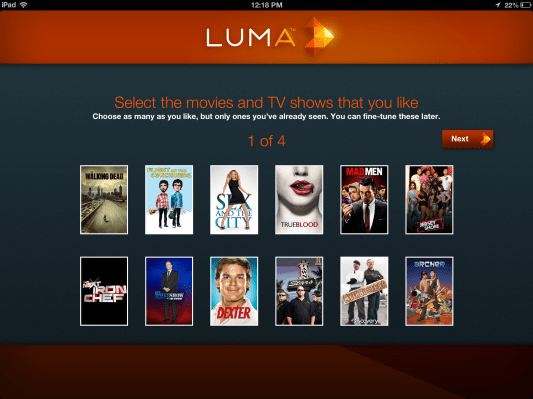Movie and TV recommendations app Luma.tv has been working to solve the “what to watch” problem for years. The company first launched as Inveni.com, a free web service backed by nearly $2 million in founder and angel funding, which helped users create their own “taste profiles” in order to serve up streaming video recommendations. Now the same technology that Inveni once used forms the basis for Luma, a newly launched iPad app that connects users to their favorite shows on Netflix, Hulu, HBO Go, Max Go, iTunes, Crackle, and other TV channels.
The result is a personalized TV guide where, instead of titles and times, you’re offered lists of shows you’ll love, and options as to all the various places you can currently view them.
The Minneapolis-based company was founded by former W3i co-founder Aaron Weber, who explains he’s long been interested in personalization technologies. According to the company’s own internal data, it was taking users on average eight minutes to decide what to watch. “We thought that was ridiculous and there were no tools to actually solve this problem,” he says. “So we’ve spent the last three years working with engineers and creating all these different solutions to the problem.”
When Inveni was first getting off the ground, the personalization problems around TV and movie recommendations were only just being addressed. Netflix, for example, offered a million-dollar grand prize to a team of engineers who could improve its algorithm by 10 percent.
“When I looked at [the Netflix prize] and what people were doing, as an entrepreneur, it became clear that this was not an engineering / science-type problem that needed to be solved. This was a data problem,” says Weber. To improve recommendations, a company really needs more user preference data, he explains. But more importantly, what made Inveni, and now Luma.tv, different is that it does object-to-object recommendations via crowdsourcing techniques rather than pure algorithms.
What that means is that Luma.tv asks workers on a large crowdsourcing platform to manually match up a movie or TV title with other, similar shows or films that a user who liked that title may also like. More crowdsourcers then go in behind those initial recommendations to refine the data. The exact details of the crowdsourcing process are something of Luma’s secret sauce, and the company has filed for a patent on the techniques involved.
“We found that algorithms doing the mapping, or movie genomes – they get you close, but it’s subjective. This is art,” Weber claims. “The crowdsourced group is helping us by confirming things are similar and also by making the connections themselves.”
Today, Luma has around 300 movie experts matching up movies and shows, who have mapped out almost 600,000 connections between items. Algorithms then fill in the long tail, making about 11 million metadata connections.
While Inveni once targeted users streaming videos on the web, Luma is a rethinking of the problem for the multi-platform, mobile-first era. Currently, the iPad app connects users to the other services they have, and in some cases, pay for, like Netflix or HBO, so they can go from Luma directly to the app in question and start watching the show.
But in about a month’s time, the company plans to add live TV into the mix as well, through integration of APIs from cable and satellite partners (like Direct TV), and connections to other platforms, like Google TV. The company plans to talk with Dish and Tivo as well, and says supporting Chromecast on the forthcoming web version of the Luma service is also something that’s now on the radar.
In addition to its crowdsourced-backed technologies, Luma wants to also offer different types of viewing suggestions that haven’t yet been seen before, like the ability to offer multi-person recommendations, for example. That means it could change its recommendations based on whether you were looking for shows to watch with the family versus watching alone by combining taste profiles.
At launch, Luma.tv offers access to over a dozen different video sources, but expects to reach about 40 by year-end. Though the underlying technology differs here, the startup broadly competes with others in this space, including recently launched app Yidio, Peel, Televised, Fan.tv (Fanhattan), and more.
Eventually, Luma.tv hopes to monetize through promoted content within the app, but in the near-term will likely first offer users tools to help them preview and compare streaming services like Amazon’s Prime Instant Video, Netflix and others, then earn affiliate income when users sign up.
The Luma.tv app is a free download here in iTunes.

![luma_availablenow[3]](https://techcrunch.com/wp-content/uploads/2013/09/luma_availablenow3.png?w=640)
![luma_detailsview[3]](https://techcrunch.com/wp-content/uploads/2013/09/luma_detailsview3.png?w=640)
![luma_activityfeed[3]](https://techcrunch.com/wp-content/uploads/2013/09/luma_activityfeed3.png?w=640)